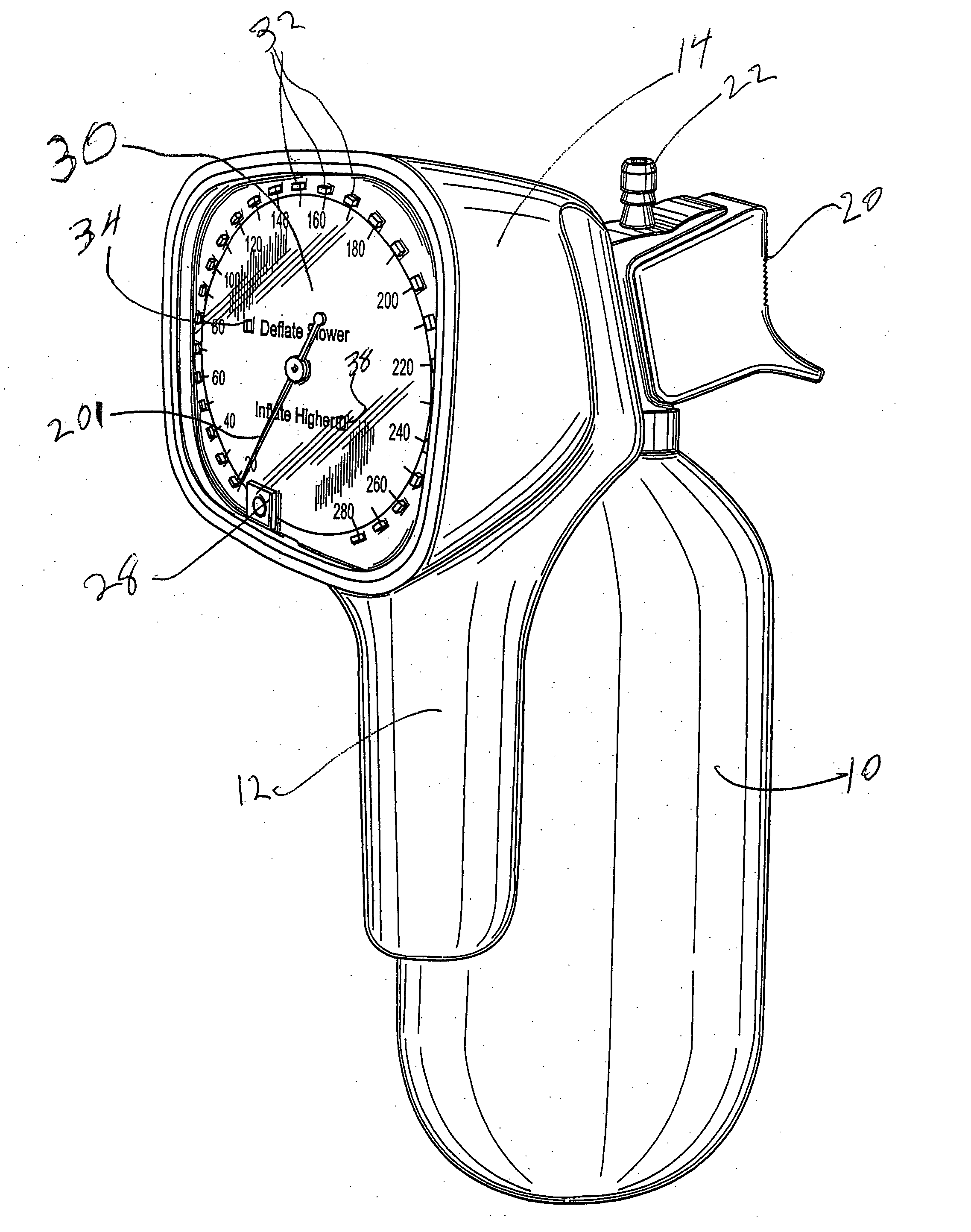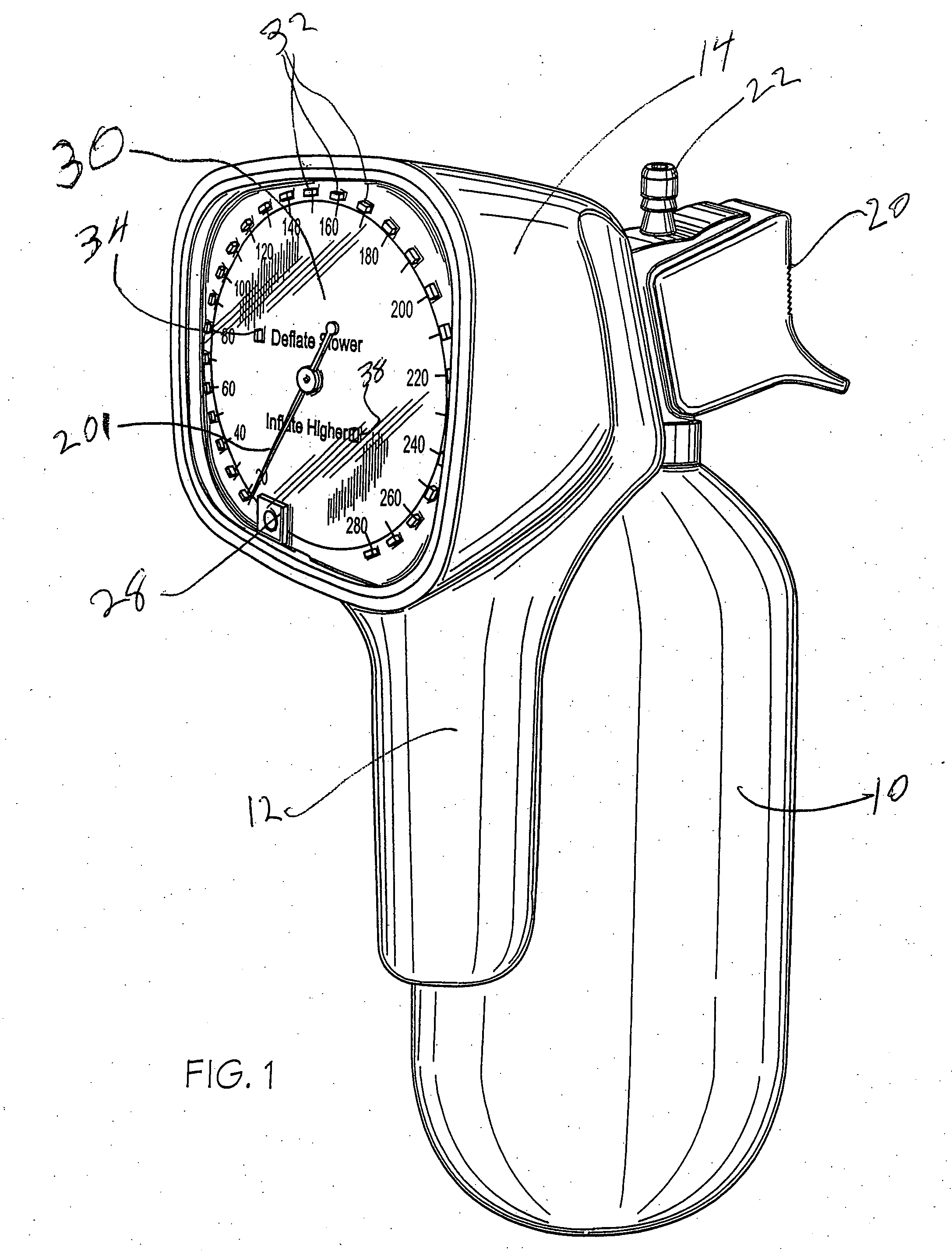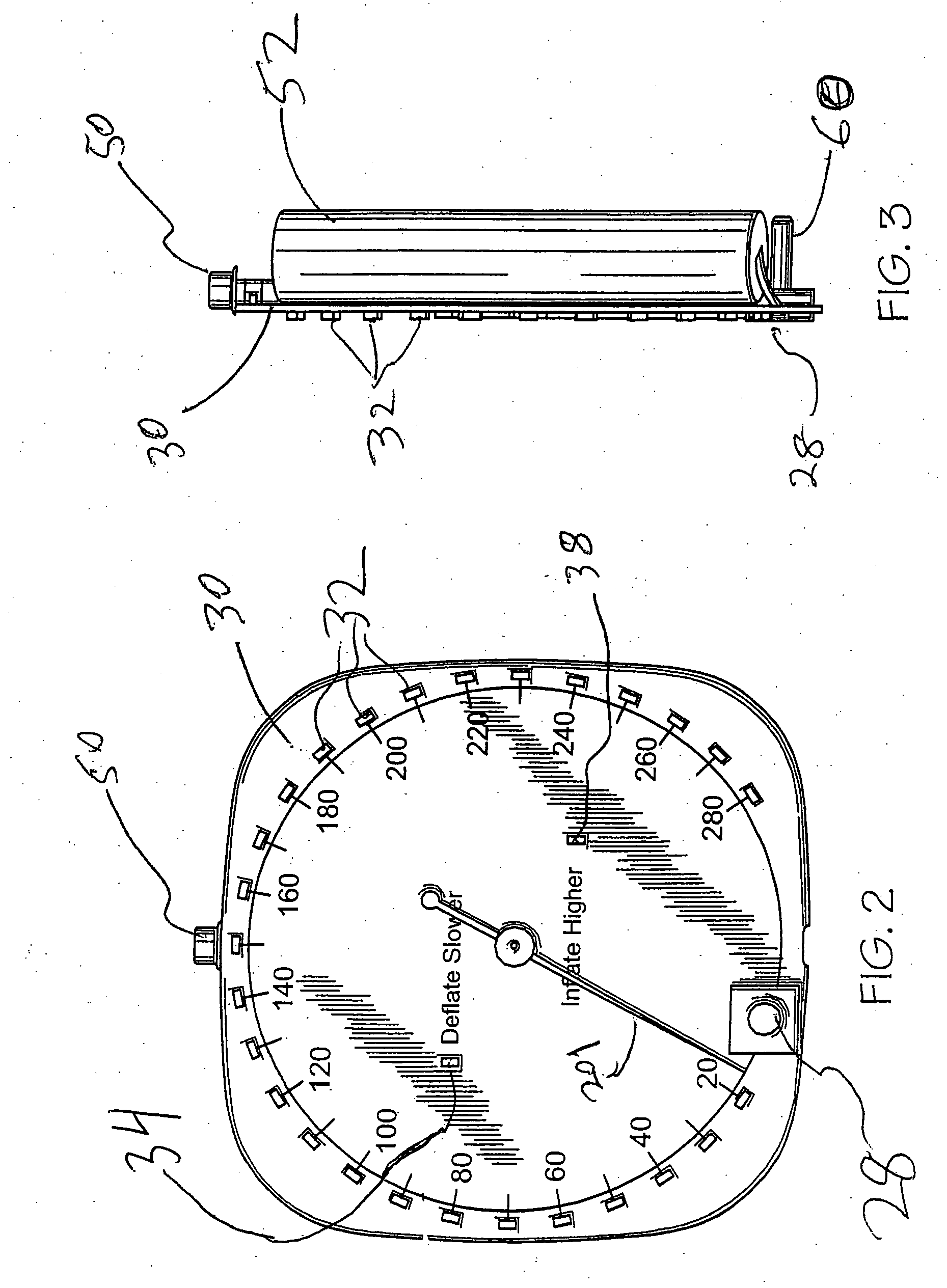Though Erlanger's oscillometric method and device were elegant, and reported to be very accurate, they were used very little due to the complexity and expense of the apparatus and were effectively doomed to obscurity for almost 75 years.
No prior art device for NIBP provides that versatility.
FMO—fully-manual oscillometric devices use aneroid or mercury gauge mechanisms to amplify the oscillation signals for
visual assessment as the
cuff pressure is manually inflated and deflated; traditional aneroid and mercury sphygmomanometers are used occasionally effectively in this mode, except often they are not sensitive enough for low flow states and fail to give sufficient oscillation indication for effective determination of the BP.
Despite the safety and the many advantages of the
fully automatic oscillometric NIBP measurement devices (FAO) and their long history of utility and safety (25+ years), there are some areas of
medicine where they do not serve the needs particularly well.
That is not to say they are not somewhat useful in many of these areas, and may well be serving there now, but simply that the prior art ubiquitous FAO devices are not optimum in these areas of use due to various of their operational considerations and limitations, including size, weight, cost, and single mode of operation.
It is often, but not always, relevant in many cases to the less expensive
consumer devices of lower accuracy and performance which however are all relatively small, relatively low priced, and battery powered, though not suited to professional use for a variety of reasons.
These low cost
consumer FAO devices are rarely ever found in the hospital, EMS vehicles, or physicians' offices.
Though not exhaustive, listed below are some known disadvantages of the DINAMAP class of FAO prior art devices.
1) Often difficult or cumbersome in the hospital to access an FAO device:
Current professional quality FAOs are large, often heavy, and rather expensive and they are often shared among many patients for measuring NIBP or are actually built into a total
patient monitor and hence are not available for use separately.
This rolling is usually easier than hand carrying, but inconvenient and a waste of time at best.
Often such required transport is more than just a time waster and inconvenience, it can actually become a major clinical problem when a patient's BP needs to be measured quickly, but the DINAMAP class NIBP device is down the hall and must be found first, and then moved to the patient.
This problem of
rapid access to an NIBP device when needed is obviously solved in some hospitals by having an FAO (DINAMAP class) at each
bed, but the expense of this option often prevents such broad deployment.
Obviously, it also requires that said caregiver be knowledgeable and practiced with the FMA method of determining BP, which is not always the case, since with the great numbers of FAO devices now in routine use with all classes of patients, it is likely that many hospital personnel have not measured FMA in several months, or even years, or ever.
2) Often difficult or cumbersome in the field access to an FAO device:
FAO are large, heavy, and expensive which limits their deployment in field circumstances where BP must be measured in urgent situations such as medical emergencies (e.g.
unconsciousness, heart attacks, and ruptured aneurysms), blunt trauma (e.g., motor vehicle accidents), and penetrating trauma(e.g. gunshot wounds and stab wounds).
Many times EMS personnel and military medics need to measure the BP routinely, but it is simply not possible to have a FAO present while actually attending the patient due to the location of the patient and the size, weight, and power requirements of hospital quality FAO devices.
Many fully equipped emergency vehicles do have FAOs built in, but even their presence in the vehicle does not always mean that they will function properly, due to patient movement caused by vehicular motion, as the ambulance moves towards a definitive
care facility, or due to
patient motion caused by patient agitation and pain.
However, FAO devices cannot pause for more than 8-10 seconds at any given
cuff pressure or the device will become very uncomfortable to the subject (if conscious) due to the production of serious venous congestion by the inflated cuff.
Additionally, when there is substantial motion artifact, particularly if it persists for many seconds, the accuracy can be severely compromised, the time for determination can prolong up to a couple of minutes, and the discomfort of the BP cuff can become severe.
Thus in difficult conditions, the result of this FAO approach to obtaining data uncontaminated with
noise artifact is that the determination may be so prolonged that it ends up producing patient pain, or alternately, the FAO device may end up accepting contaminated data and hence present an incorrect reading, or, it may “
timeout” and simply
deflate the cuff without actually determining the BP.
If it fails again, it will alarm to let the user know there is a problem with the determination.
So, though capable of recognizing
noise artifact and pausing, waiting for it to cease before it continues its process of making the BP determination, there are circumstances where the motion artifact is such that it is impossible to get a good FAO reading.
However, continuous
deflate FAOs may potentially recognize the arrhythmia, but do not pause cuff deflation and hence pass through potentially important cuff pressures without sampling truly representative
cuff pressure oscillation data.
Continuous
deflate devices which pause in the presence of arrhythmia (or motion artifact) suffer the same problems of the step deflate devices.
Some arrhythmias such as
atrial fibrillation, produce an extremely erratic
heart rate and hence occasionally extreme beat to beat variations in the force of the ventricular beat and hence the actual level of pressure created by each beat in the arterial
system.
This variability of intra-arterial BP causes a similar variability of the
cuff pressure oscillations (which all FAOs use to measure the BP) and hence create great difficulty for the FAO in its effort to accurately determine the BP.
In truth, this extreme circumstance of intra-
arterial blood pressure variability actually makes it difficult to say exactly what the BP is since it is varying so much and so rapidly.
The absence of the
mechanical pressure sensing and display saves cost, but it eliminates the dual
system redundancy of the combined device.
However, when the mechanical sensing and display components are omitted, the desirable feature of redundancy is eliminated which implies the device is worthless if the batteries are exhausted or if there is an electronic failure.
Similarly, without the redundancy achieved by having both mechanical and electronic
pressure sensing and display systems, the user is not afforded the constant indication of proper system calibration provided by the constant displays of cuff pressure by the two independent
pressure sensing and display systems.
Thus, because the simplest and least expensive embodiment of my device has only the electronic sensing and display system, the savings in cost and manufacturing complexity allow greater utilization, but such redundancy
elimination does reduce the safety and versatility of the device.
An alternative approach to redundancy in one embodiment of my inventive device is to have two redundant
electronic systems, which does increase confidence in proper functioning and calibration, but such electronic redundancy is almost as expensive as having the
mechanical system redundancy.
However if these two totally independent cuff pressure measuring systems disagree in their indication of the magnitude of the cuff pressure at any time, it indicates that at least one of them is wrong and that either one or both are either broken or at least in need of calibration.
. . the fields of hypertension research, hypertension diagnosis, and
hypertension treatment are all based on accurate full manual auscultatory (FMA)
blood pressure determinations and without the use of the known accurate mercury manometer, the values of NIBP measured using mechanical gages are suspect due to their known tendency to be significantly out of calibration.
Also, FAO devices are being used now for BP research and without the constant indication of proper calibration that my invention provides, these electronic measurements have to be regarded as suspect unless they are checked for calibration very often, something not traditionally done due to its cost and inconvenience.
This is true due to the dissimilar redundancy provided by having one each of a
mechanical pressure sensing and display system and one of an electronic
pressure sensing and display system, since it would be nearly impossible for both the mechanical AND electronic measurement and indicating systems to be broken or out of calibration by exactly the same amount and in the same direction of error.
 Login to View More
Login to View More  Login to View More
Login to View More 


